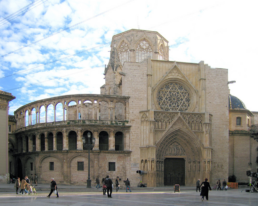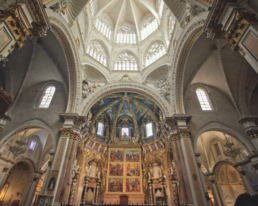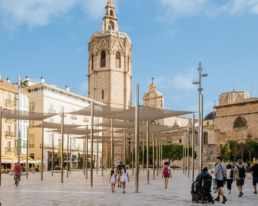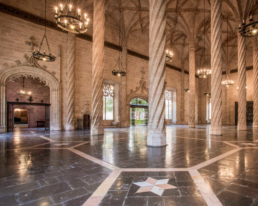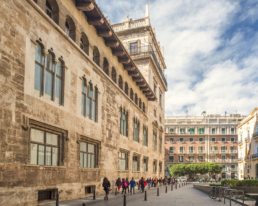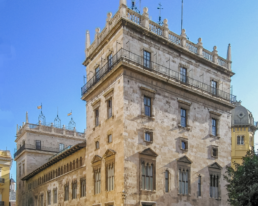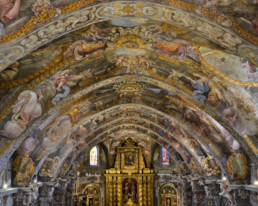Historic Architecture in Valencia: What to See
DATE
10.09.2025
Valencia has become a landmark destination for discovering the extraordinary material traces left by its history.
Nowhere is this layering of styles and eras better appreciated than in its Cathedral, a building in constant evolution since the 13th century. Originally constructed on the site of an ancient mosque, the Cathedral of Santa María incorporates Romanesque elements in its apse and side portal, Gothic in its nave, the Apostles’ Gate, and vaults, Renaissance in its Puerta de los Hierros, and Baroque in its interior decorations. Its iconic bell tower, the Miguelete, rises as a city symbol and offers one of the best views over Valencia. Inside, highlights include the Chapel of the Holy Grail—guardian of the relic that, according to tradition, was used by Christ at the Last Supper—and the Renaissance frescoes of the main altar. This richness of styles confirms Valencia’s vocation as a crossroads of cultures, periods, and approaches to architecture.
One of the finest exponents of Valencia’s commercial splendor in the 15th century is the Silk Exchange (La Lonja de la Seda), declared a UNESCO World Heritage Site. Built between 1482 and 1548 by architect Pere Compte, it is a masterpiece of European civil Gothic. Its Columnar Hall, with helicoidal columns rising like stone palm trees, creates a space as solemn as it is harmonious. Next to it, the Consulate of the Sea housed merchant assemblies and maritime courts, underlining the city’s role as a Mediterranean economic hub. Alongside, the defensive tower completes an urban ensemble of remarkable expressive power. This building is one of the best examples of how architecture can be at once functional, symbolic, and extraordinarily beautiful.
Institutional and religious buildings complete the panorama of Valencia’s historic architecture. The Palau de la Generalitat, seat of the regional government, is a Gothic construction begun in the 15th century with a refined Renaissance extension in the 16th. Its sober façade leads into richly adorned interiors, such as the Golden Hall and the cloistered courtyard. The Convent of Santo Domingo, located in Plaza de Tetuán, was one of the main Dominican centers of the Crown of Aragon. Its cloister, chapter house, and Chapel of the Kings combine Valencian Gothic with Baroque details. Among the city’s most notable churches is San Nicolás, whose interior has been recently restored to reveal a sumptuous Baroque decoration, earning it the nickname “the Valencian Sistine Chapel.” Santa Catalina, with its slender tower, and San Juan del Hospital, the city’s oldest church (13th century), add further contrasts to this historical route.
A lesser-known but highly interesting site is the former Convent of the Trinitarians, founded in the 13th century and transformed over time. Its austere church and Baroque cloister retain the contemplative atmosphere of monastic spaces, today adapted for cultural uses. This convent, along with the other works mentioned, offers a complete vision of how Valencia has preserved its historic legacy.
The city is a true architectural palimpsest, where each building not only tells its own story but also engages in dialogue with others to shape a rich, complex, and deeply rooted urban identity. Visiting historic Valencia is an experience that reveals how power, faith, commerce, and beauty have been interwoven over the centuries.
MArch Valencia. Arquitectura y Diseño
© 2025 MArch Valencia. Arquitectura y Diseño
Privacy policy | Cookies policy | Terms of use
